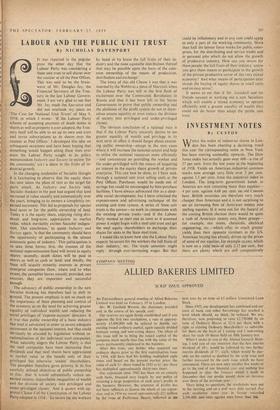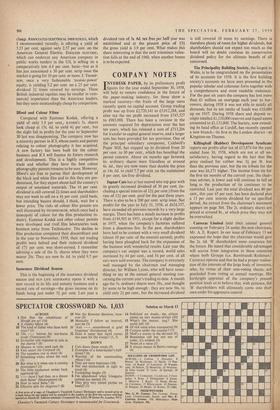INVESTMENT NOTES
By CUSTOS,
the index of industrial shares in Lon- don has been charting a declining trend this year the corresponding index in New York has been moving unsteadily upwards. The Dow Jones index has actually gone over 600—a rise of 37 per cent, from the loW point at..the beginning of 1958. Yields on American ,industrial common stocks now average very little , over 3 per cent. against 5.3 per cent: from the industrial index in London. The long-term government bonds in America are now returning more than equities- 4 per cent. against 4.68 per cent. on old Consols here. British securities are therefore very much cheaper than American and it is not surprising to see an increasing -flow of American money into sterling equities:AI it were not for the hazard of the coming British, election there would be quite a rush of American money into those groups— for example, our stores, chemicals, electrical engineering, etc.—which offer so much greater yields than their opposite numbers . in the US. American buying has already driVen up the prices of some of our equities, for example otAxo, which is now on a yield basis of only 2.15 per cent,, but there are plenty which are still comparatively
cheap. ASSOCIATED ELECTRICAL INDUSTRIES, WhiCh I recommended recently, is offering a yield of 5.35 per cent, against only 2.57 per cent, on the American General Electric. ENGLISH ELECTRIC, which can undercut any American company in public works tenders in the US, is selling on a comparatively low 4.4 per cent. basis-but as it has just announced a 50 per cent. scrip issue the market is going for 10 per cent, or more. J. THOMP- SON, once a very fashionable 'atomic-power' equity, is yielding 5.2 per cent. on a 25 per cent. dividend 24 times covered by earnings. These British industrial equities may be smaller in com- mercial importance than the American leaders, but they seem outstandingly cheap by comparison.
Word and Colour Films Compared with Eastman Kodak, offering a yield of only 1.9 per cent., ILFORD'S 5s. shares look cheap at 17s. 6d. to yield 44 per cent., but the slight fall in profits for the year to September 30 last was disappointing. The company now has a minority partner in ICI, whose assets and patents relating to colour photography it has acquired. A new factory has been built for the colour business and ICI will finance its future research and development. This is a highly competitive trade and whether they have the best colour photography patents remains to be seen. However, Ilford's are free to pursue their development of the black and white film and in this they are pre- dominant, for they export about half the country's output of sensitised materials. The 16 per cent. dividend is still covered 24 times and shareholders may not want to sell on a 44 per cent. yield basis, but intending buyers should, I think, wait for a lower price. The risks of colour film patents are well illustrated by TECHNICOLOR, which once had a monopoly of colour for the film production in- dustry. Eastman Kodak and other colour patents were developed and rival film laboratories took business away from Technicolor. The decline in film production completed their discomfiture and in the year to November, 1958, their net trading profits were halved and their reduced dividend of 174 per cent, was short-earned. I remember advising a sale of the 5s. shares when they were nearer 20s. They are now 8s. 6d. to yield 9.7 per cent.
Insurance Dividend Season
This is the beginning of the insurance dividend season and SUN LIFE ASSURANCE opens it with a new record in- its life and annuity business and a record rate of earnings-the gross income on its funds being just under 53 per cent. Last year a
dividend rate of 3s. 6d. tax free per half year was established and at the present price of 154 the gross yield is 3.9 per cent. What makes this share interesting is that the next triennium valua- tion falls at the end of 1960, when another bonus is to be expected.



































 Previous page
Previous page